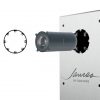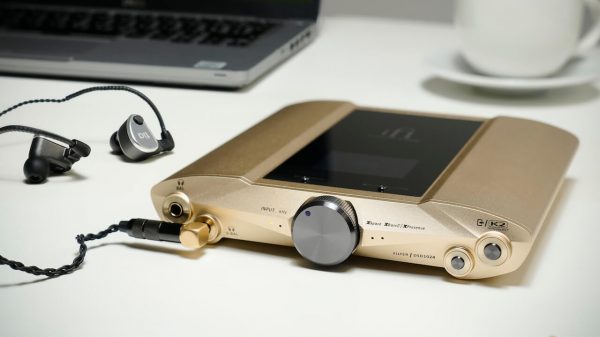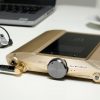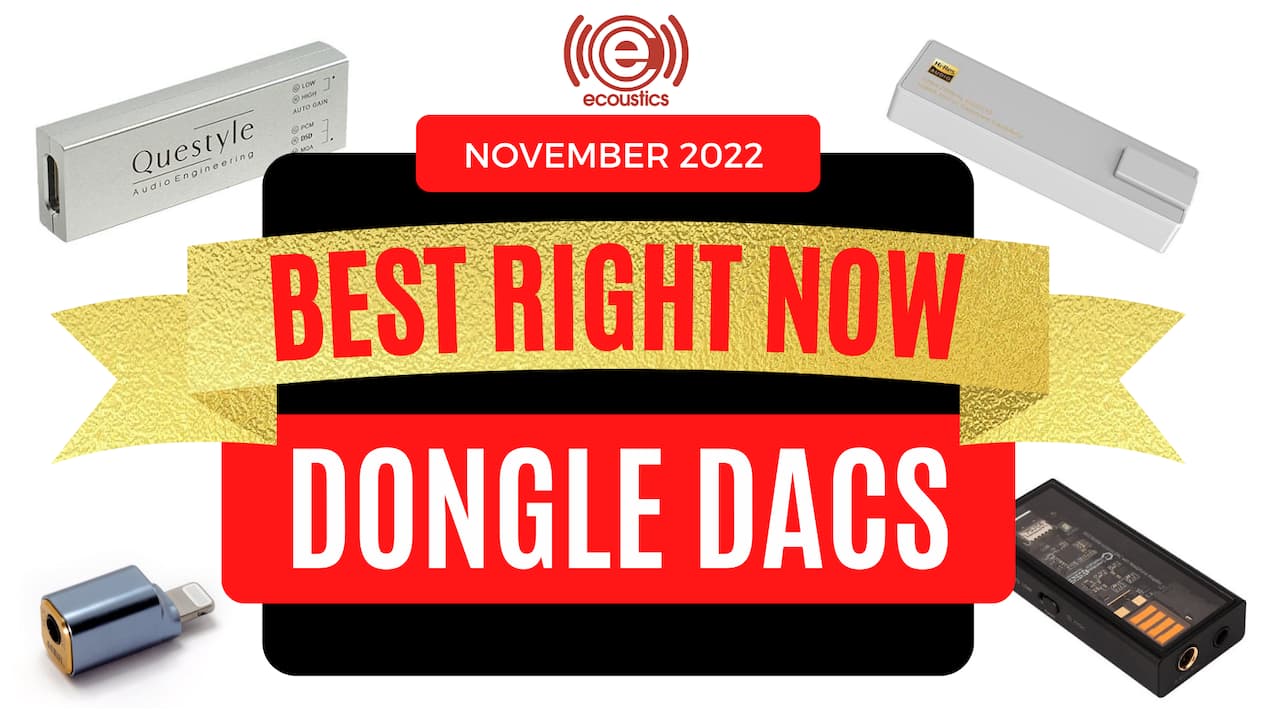iFi Audio is celebrating its 10th birthday in 2022 and the British manufacturer of award-winning and very popular desktop and portable audio solutions is firing on all cylinders at the moment. We recently tested the iFi GO Bar Dongle DAC and discovered that their first truly portable DAC/Headphone Amplifier is one of the best we have tried so far. The iFi xDSD Gryphon, released late 2021, is a much more powerful and capable device than its smaller sibling and we took it for a long ride.
AudioQuest has owned this category for years but their products have fallen behind IFi, CEntrance, Questyle, FiiO, Apogee, THX, Helm Audio, and a growing list of start-ups.
If you have been part of the Head-Fi revolution over the past decade, you are likely very familiar with iFi and their products; many of us have multiple generations of their products on our desks (or inside of them) and use their rather extensive selection of accessories with our smart phones, DAPs, headphone systems, and portable rigs. The products have become more expensive over the years but the quality has gone up so you are getting a lot of innovation and durability for your money.

A quick look through my own personal collection reveals the first generation iFi xDSD which I purchased not long after it was announced in 2018. The device was the Swiss army knife of portable audio at the time with a long list of features and the ability to use it as a standalone headphone amplifier, DAC/amplifier, Bluetooth DAC/amplifier, and a desktop USB DAC in a package slightly larger than a deck of cards.
The xDSD offered roughly 6 hours of battery life and ample power to run just about any headphone (500mW@16Ω). For its day, it was a market leader and it still gives up very little to most of its recent counterparts in the market.
However, 2018 is not 2022 and the market has changed a lot over the past four years; the plethora of Dongle DACs from more than 2 dozen manufacturers at this point has been well received by the market and it would appear that consumers prefer the concept of using a smartphone and Dongle DAC to handle the DAC/amplifier side of the equation versus something like the xDSD.
We can understand that level of thinking from the perspective of size/form but that is only part of the equation.
You invest in a portable DAC/amplifier because it has the ability to drive your headphones properly and deliver far superior sound quality to the solution inside of your source device.
The issue with that approach is that most Dongle DACs are limited in terms of how much power they can provide; thus limiting which headphones can be used with them.
If you are using a USB Type-C model which can offer 5V@150mA or a lightning version that is even more limited at 4.8V@120mA, there is only so much that can be accomplished.
Driving a pair of full-sized headphones and trying to preserve your smartphone’s battery life might be a lost cause.
The aforementioned iFi GO Bar is certainly a good middle ground but it still can’t drive difficult headphones to the same levels as the iFi xDSD Gryphon.

The Skinny
As the successor to the original xDSD (from a technical perspective, it’s an xDSD Gryphon), it was mandatory that the Gryphon offer the same features of the original and it does with one exception. The original xDSD included a combination Coax/Toslink S/PDIF connector while the Gryphon only offers a Coaxial input so if you are using Optical inputs, know that you will have to switch to USB or Coaxial if switching to the new iFi XDSD Gryphon.
The Optical input made more sense in 2018 when USB was still experiencing growing pains but in today’s world with higher bit rates, and DSD and MQA available through USB only, the use of Coaxial and Optical inputs on portable devices has plummeted, so iFi decided rather than spend time on an Optical decoder, that it was a better use of their resources to invest in other features.
The iFi xDSD Gryphon offers support for USB, Coaxial, Bluetooth aptX Adaptive, LDAC, HWA/LHDC, AAC, aptX, and SBC protocols using the latest Qualcomm Q5100 series chipset. Regardless of which input is used, the signal is synced to a global master clock to reduce jitter before being passed to the Burr-Brown chip handling the DAC duties.
The xDSD Gryphon supports PCM up to 32-bit/768kHz, DSD512, and 8x MQA and DXD. The Gryphon also exposes the filters of the DAC so users have a choice of 3 modes; standard, bit-perfect, and Gibbs Transient Optimized, each of which offers a slightly different sound.

The brain of the Gryphon is a 16 core XMOS processor that handles all of the task delegation, controls, display, and MQA unfolding duties as the Burr-Brown chips do not support MQA natively.
The XMOS and Burr-Brown DAC use a custom firmware developed at iFi. After passing through the DAC section, the signal is fed to a dual-mono amplifier circuit with the final quartet of chips in each channel biased at 0v DC. This allows the amplifier to operate without capacitors in the signal path which helps reduce noise and distortion as does the balanced circuit design.
The negative feedback system designed by iFi to control the amplifier also helps further reduce noise. iFi calls this Purewave and Optimaloop and both technologies started out in their pro line with the Diablo and Gryphon being their first portable devices that implement the technology.

The volume control is in the analog domain and is more intricate than most; iFi has developed what it calls CyberSync which detects the source OS in use and bypasses that device’s internal software volume control. This means that the volume adjustment is always done on the Gryphon even if the user adjusts the slider in Windows or Android.
This allows iFi to customize the volume adjustments for different operating systems; it also also ensure that the source signal is not degraded by the software volume controls before reaching the Gryphon.
One of the most impressive aspects of the iFi xDSD Gryphon is its versatility; the ability to go from a portable DAC/headphone amplifier to desktop preamplifier connected to a pair of active loudspeakers is rather unique in the portable category. None of this would matter if the unit didn’t deliver sonically, but it is clearly near the top of its class in that respect.

All of those features and power come with some dramatic changes to the physical design as well; the xDSD Gryphon is double the size of the original unit (5″ x 3″ x .75″) and weighs 8 ounces.
iFi have retained the wave pattern of the original unit but the matte finish works better and is much easier to keep clean.
The front panel features 3.5mm and 4.4mm headphone jacks, two LEDs that indicate the kHz and input type, a large multi-function knob that is dead center on the faceplate, and two more LEDs for XBass II and XSpace. The right side of the panel also includes a button for the settings, and input selection button.
The rear panel is rather busy but well spaced out; users will find a 3-position XBass/Bass Presence switch, and two USB Type-C ports (one is for charging and the other is a source input).
The USB charging port has a battery indicator LED which changes color when you are charging and fully charged. The final pieces of real estate are occupied by the digital Coaxial input, 4.4mm input, and a single 3.5mm input.
iFi provides a carrying bag for the xDSD Gryphon but I would suggest picking up the new dedicated case for the unit that was just released and provides better protection.

The supplied manual is mandatory reading; I spent two days reading it and experimenting with every possible setting and connectivity option. Do not try to figure everything out by trial and error — read the damn manual. It will save you a lot of questions and frustration.
I did find that pairing was simple and Bluetooth connectivity was above average using both LDAC between the Gryphon and Astell&Kern’s KANN MAX DAP and my Samsung phone with aptX HD and HWA.
Sound
The original xDSD was a great sounding unit, but I wondered if the the new xDSD Gryphon priced at $599 would deliver a better performance this time. All of these features would not mean very much if the unit did not compare favorably to the Chord Mojo 2 and the CEntrance unit that I just finished reviewing.
I connected the xDSD Gryphon to a MacBook Pro, Windows laptop, iPhone 12, and a Samsung S21 to see how it handled different sources; I did play with all of the DAC settings but decided that the bit-perfect mode worked the best.
With the XBass II setting disabled, it was rather clear that the xDSD Gryphon has very impressive low end performance; bass notes have strong definition, impact, and a lot of texture. The clarity in the low end was also excellent and when I used headphones that could show it off — it was clear that the unit is capable of letting you hear the differences between bass guitars and percussion instruments.
That is not very common with portable units like this and I was happy to hear that the performance did not fall off as we moved into the mid bass and upper bass regions; the impact remained very strong but with excellent linearity and texture.
There was no bleed into the lower midrange and it keeps things very clean in this range; even turning the XBass II on did not cause the bass to overwhelm the rest of the music.
With it engaged, bass notes are pushed further forward in the presentation but it never becomes distracting and it certainly never loses its definition. That is the way it should be done. Well done iFI Audio.
The midrange performance of the xDSD Gryphon started to make me think that the Chord Mojo 2 might not be the best in the category anymore; the iFi offers excellent resolution, transparency, detail, and very fast transient response which gave electric guitar a rather satisfying growl and some roughness which I found to be rather realistic sounding.
Strings and piano also displayed excellent resolution, timbre, and just enough energy and presence to sound quite realistic; the level of decay and color with each instrument really made me sit up and pay closer attention to the music.
The treble is well extended with enough airiness and detail to give everything in the range a lot of presence; the xDSD Gryphon is clearly designed for listeners like myself who want that extra sparkle but without feeling any sense of fatigue or a closed-off top end. Music never feels rolled off and it would be incorrect to suggest that the treble is elevated at all.
Percussion has very good snap and cymbals sound quite realistic and never overly metallic; provided that your headphones are up to the task.
Typical of the iFi house signature and maybe the Burr-Brown DAC it uses, the highs are a touch thin which helps with clarity and definition, but won’t have as much heft as some others, Personally, I find this tuning more natural in its overall tonality.
Vocals cut through the mix well regardless of pitch and female voices stand on an even footing with their male counterparts. Male vocals are a touch thicker than their female counterparts which again sounded more natural to me and the xDSD Gryphon made listening to Pentatonix fun with its punchy bass and well extended upper range.
It is difficult to give a DAC/headphone amplifier too much credit for the size of the soundstage or imaging; both are so dependent on the headphones on the other end but I will say that listening with the Sennheiser HD800 and Audeze LCD-4 was very interesting in that regard.
Both headphones are renowned for their ability to throw a huge soundstage and lesser headphone amplifiers don’t have the ability to build on those capabilities — the iFi xDSD Gryphon proved to be on equal footing and I was quite impressed by how it didn’t exaggerate the width and depth with the XSpace feature engaged.
One final note — the iFi xDSD Gryphon is designed for harder to drive headphones and you will have to engage IE-Match on the bottom for most IEMs to avoid hearing some level of hiss.

Battery Life
The battery performance depends on a number of variables; volume level, headphone type, and how you use the features. Bluetooth certainly drained the battery far more quickly than using the USB input and high impedance/low sensitivity headphones caused a more rapid decline than high sensitivity IEMs.
The worst performance scenario still delivered over 7 hours of playtime before requiring a charge, and best delivered almost 10 hours. What does that mean for you?
The iFi xDSD Gryphon is capable of making it through a business day at the office on a single charge or a full day on campus; the downside is that it requires all night to recharge (almost 12 hours) unless you are using a 2.1A charger which cuts the charging time to only 6 hours.
Conclusion
The original iFi xDSD was a category leading device when it was released in 2018 because it offered so much performance for the money. It did almost everything you would need. The casework was a bit of an issue because of the slick surfaces and finish that was a fingerprint magnet.
iFi has taken those lessons to heart and delivered a new xDSD Gryphon with a rougher and matte finished aluminum shell. It is not as slick but likely to stand up better long-term to abuse and remain very clean.
The new unit supports all of the new Bluetooth protocols with the exception of aptX Lossless, offers better battery performance, more tuning options, and double the amount of power.
The versatility of the xDSD Gryphon is also a huge selling point; it can feed a desktop amplifier as a DAC or serve as a DAC/pre-amplifier for a pair of active loudspeakers.
The improved battery life makes it rather ideal for the commuter or student who need a powerful DAC/headphone amplifier that will not run out of juice even if you have to stay late in the office or library after class. The upgrade in power is substantial which only widens the appeal.
The overall package faces some stiff competition from the Chord and CEntrance offerings that sit at the top of my recommended list — but taking everything into account, the iFI xDSD Gryphon is more versatile than either of them, offers more tuning options, and delivers better sound quality depending on the headphones you use.
Does it make sense to spend $599 on the iFi xDSD Gryphon?
When you consider that it is more affordable than its two main rivals, it might be the most logical one to buy.
A “Best of 2022” product for sure.
Where to buy:


































NickFury
September 3, 2022 at 7:59 pm
It’s definitely the BEST product of 2022 .